Slotted E-Shaped Meta-Material Decoupling Slab for Densely Packed MIMO Antenna Arrays
Abstract
:1. Introduction
2. Methodology of Design and Measurement Analysis
2.1. Antenna Array without Decoupling Slab
2.2. Antenna Array with Metamaterial Decoupling Slab
2.3. Antenna Array with Slotted Meta-Material Decoupling Slab
3. Radiation Pattern of the Antenna Arrays
4. Results and Discussion
5. Conclusions
Author Contributions
Funding
Acknowledgments
Conflicts of Interest
References
- Ren, J.; Hu, W.; Yin, Y.; Fan, R. Compact Printed MIMO Antenna for UWB Applications. IEEE Antennas Wirel. Propag. Lett. 2014, 13, 1517–1520. [Google Scholar]
- Sharawi, M.S.; Rajo-Iglesias, E. MIMO antennas. In Wideband, Multiband, and Smart Reconfigurable Antennas for Modern Wireless Communications, Dauphin; IGI Global: Hershey, PA, USA, 2015; pp. 145–175. [Google Scholar]
- Katalinic, A.; Nagy, R.; Zentner, R. Benefits of MIMO Systems in Practice: Increased Capacity, Reliability and Spectrum Efficiency. In Proceedings of the 48th International Symposium ELMAR-2006 Focused on Multimedia Signal Processing and Communications, Zadar, Croatia, 7–9 June 2006. [Google Scholar]
- Abdullah, M.; Kiani, S.H.; Iqbal, A. Eight Element Multiple-Input Multiple-Output (MIMO) Antenna for 5G Mobile Applications. IEEE Access 2019, 7, 134488–134495. [Google Scholar] [CrossRef]
- Nadeem, I.; Choi, D. Study on Mutual Coupling Reduction Technique for MIMO Antennas. IEEE Access 2019, 7, 563–586. [Google Scholar] [CrossRef]
- Zhang, B.; Jornet, J.M.; Akyildiz, I.F.; Wu, Z.P. Mutual Coupling Reduction for Ultra-Dense Multi-Band Plasmonic Nano-Antenna Arrays Using Graphene-Based Frequency Selective Surface. IEEE Access 2019, 7, 33214–33225. [Google Scholar] [CrossRef]
- Roy, S.; Chakraborty, U. Mutual Coupling Reduction in a Multi-band MIMO Antenna Using Meta-Inspired Decoupling Network. Wirel. Pers. Commun. 2020, 114, 3231–3246. [Google Scholar] [CrossRef]
- Chen, X.; Zhang, S.; Li, Q. Review of mutual coupling in MIMO ystems. IEEE Access 2018, 6, 24706–24719. [Google Scholar] [CrossRef]
- Chouhan1, S.; Panda2, D.K.; Gupta, M.; Singhal, S. Multiport MIMO antennas with mutual coupling reductiontechniques for modern wireless transreceive operations: A review. Int. J. RF Microw. Comput. Aided Eng. 2017, 28, 1–13. [Google Scholar]
- Kou, N.; Shi, Y.; Li, L. New equivalent circuit analysis and synthesis for broadband composite right/left-handed transmission line metamaterials. ACES. J. 2016, 31, 884–893. [Google Scholar]
- Zhang, Q.; Jin, Y.; Feng, J.; Lv, X.; Si, L. Mutual coupling reduction of microstrip antenna array using metamaterial absorber. In Proceedings of the 2015 IEEE MTT-S International Microwave Workshop Series on Advanced Materials and Processes for RF and THz Applications (IMWS-AMP), Suzhou, China, 1–3 July 2015. [Google Scholar]
- Paul, L.C.; Haque, M.A.; Haque, M.A.; Rashid MM, U.; Islam, M.F.; Rahman, M.M. Design a slotted metamaterial microstrip patch antenna by creating three dual isosceles triangular slots on the patch and bandwidth enhancement. In Proceedings of the 3rd International Conference on Electrical Information and Communication Technology (EICT), Khulna, Bangladesh, 7–9 December 2017. [Google Scholar]
- Pyo, S.; Baik, J.-W.; Cho, S.-H.; Kim, Y.-S. Metamaterial-based antenna with triangular slotted ground for efficiency improvement. Electron. Lett. 2009, 45, 144–146. [Google Scholar] [CrossRef]
- Yu, B.; Li, Q.; Wang, H.; Li, Y.; Yang, G. Metamaterial-based low-profile broadband hexagonal-grid-slotted patch antenna. In Proceedings of the International Applied Computational Electromagnetics Society Symposium (ACES), Suzhou, China, 1–4 August 2017. [Google Scholar]
- Islam, M.; Adel, A.A.; Mimi, A.; Yasmin, M.; Norun, F. Design of Dual Band Microstrip Patch Antenna using Metamaterial. IOP Conf. Ser. Mater. Sci. Eng. 2017, 260, 012037. [Google Scholar] [CrossRef]
- Shafique, M.F.; Qamar, Z.; Riaz, L.; Saleem, R.; Khan, S.A. Coupling suppression in densely packed microstrip array using metamaterial structure. Microw. Opt. Technol. Lett. 2015, 57, 759–763. [Google Scholar] [CrossRef]
- Qamar, Z.; Naeem, U.; Khan, S.A.; Chongcheawchamnan, M.; Shafique, M.F. Mutual coupling reduction for high-performance densely packed patch antenna arrays on finite substrate. IEEE Trans. Antennas Propag. 2016, 64, 1653–1660. [Google Scholar] [CrossRef]
- Alibakhshikenari, M.; Virdee, B.S.; Shukla, P.; See, C.H.; Abd-Alhameed, R.; Khalily, M.; Falcone, F.; Limiti, E. Interaction Between Closely Packed Array Antenna Elements Using Meta-Surface for Applications Such as MIMO Systems and Synthetic Aperture Radars. Radio Sci. 2018, 53, 1368–1381. [Google Scholar]
- Amendola, G.; Boccia, L.; Massa, G. Shorted elliptical patch antennas with reduced surface waves on two frequency bands. IEEE Trans. Antennas Propag. 2005, 53, 1946–1956. [Google Scholar] [CrossRef]
- Jackson, D.R.; Williams, J.T.; Bhattacharyya, A.K.; Smith, R.L.; Buchheit, S.J.; Long, S.A. Microstrip patch designs that do not excite surface waves. IEEE Trans. Antennas Propag. 1993, 41, 1026–1037. [Google Scholar] [CrossRef]
- Alibakhshikenari, M.; Virdee, B.S.; Shukla, P.; See, C.H.; Abd-Alhameed, R.; Falcone, F.; Limiti, E. Meta-surface wall suppression of mutual coupling between microstrip patch antenna arrays for THz-band applications. Prog. Electromagn. Res. Lett. 2018, 75, 105–111. [Google Scholar] [CrossRef] [Green Version]
- Farsi, S.; Aliakbarian, H.; Schreurs, D.; Nauwelaers, B.; Vandenbosch, G.A. Mutual coupling reduction between planar antennas by using a simple microstrip U-section. IEEE Antennas Wirel. Propag. Lett. 2012, 11, 1501–1503. [Google Scholar] [CrossRef]
- Tang, M.C.; Xiao, S.; Wang, B.; Guan, J.; Deng, T. Improved performance of a microstrip phased array using broadband and ultra-low loss metamaterial slabs. IEEE Antennas Propag. Mag. 2011, 53, 31–41. [Google Scholar] [CrossRef]

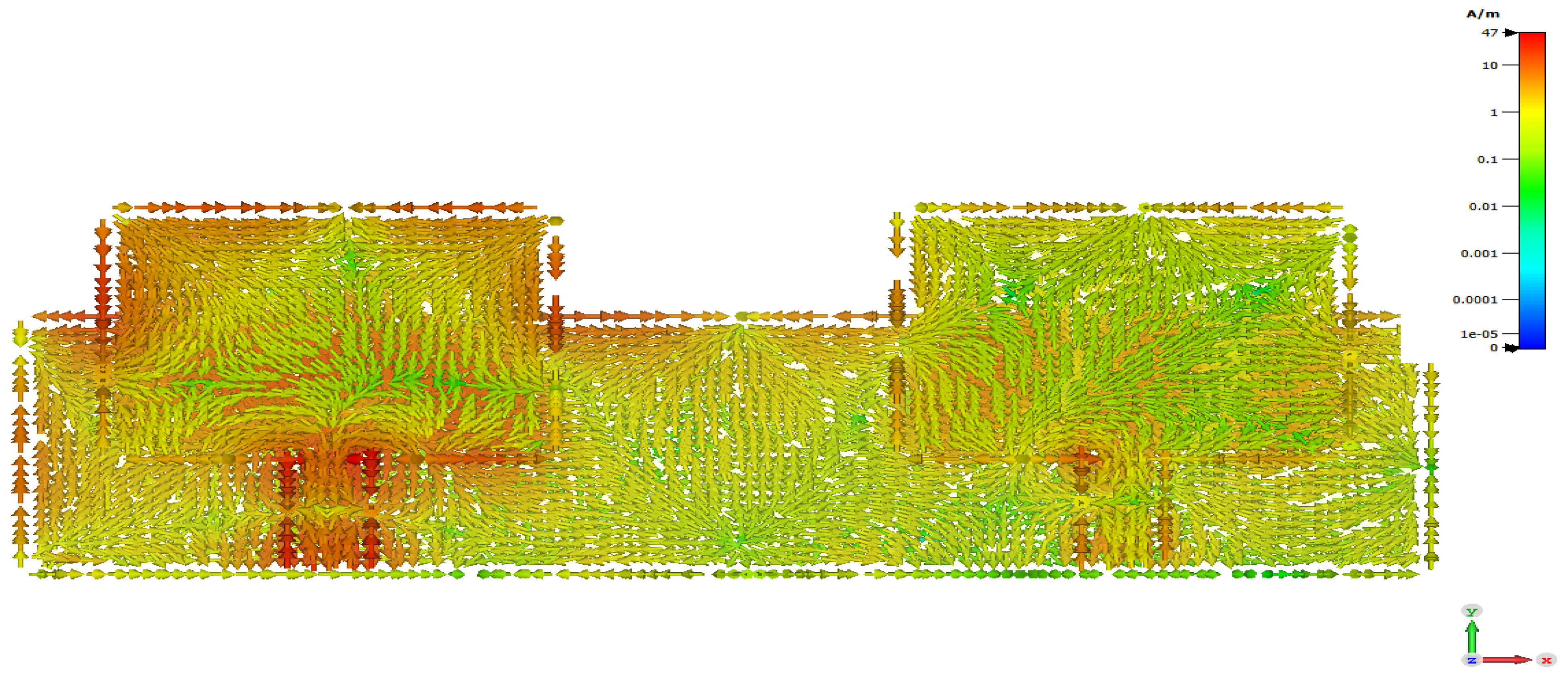
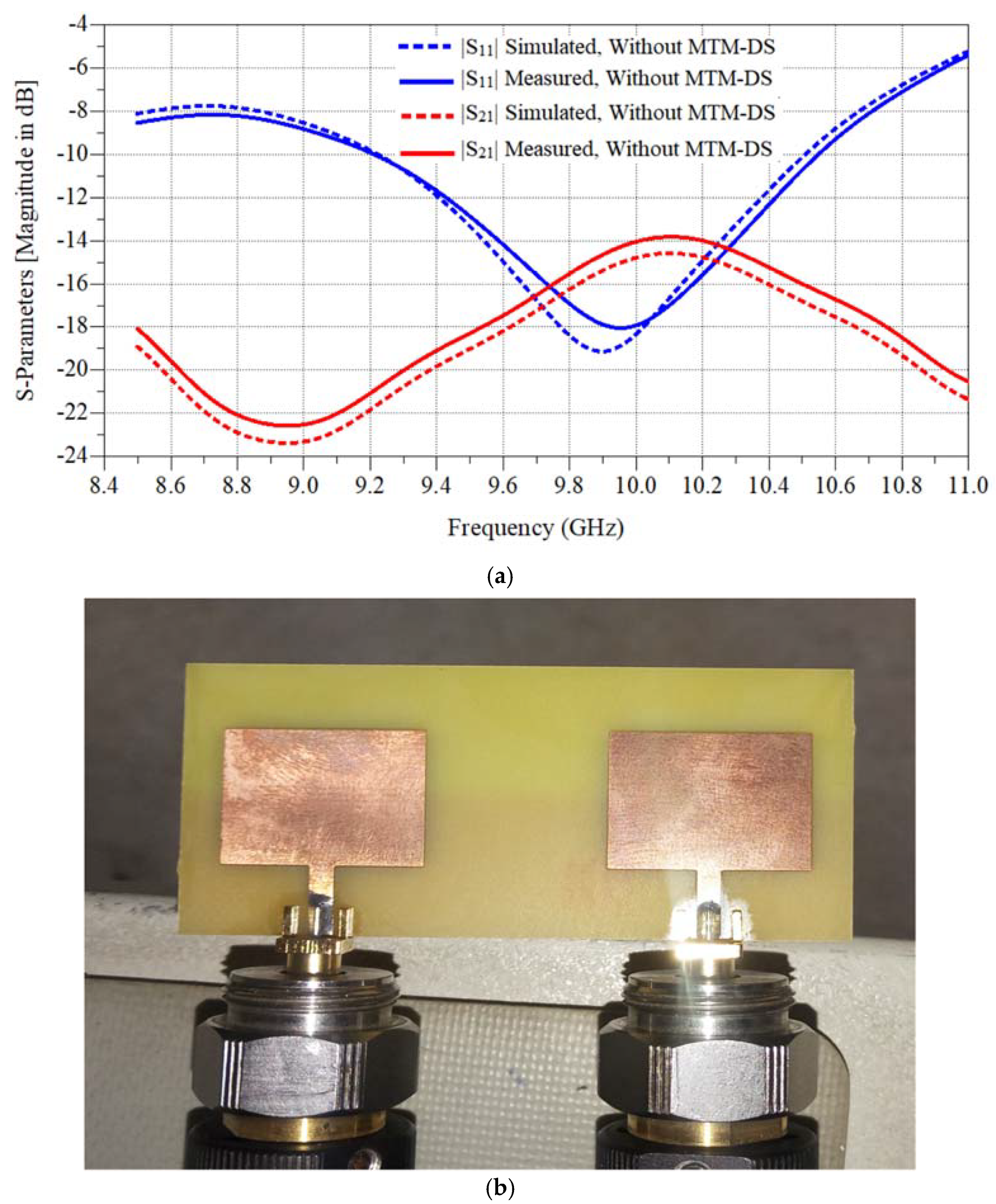
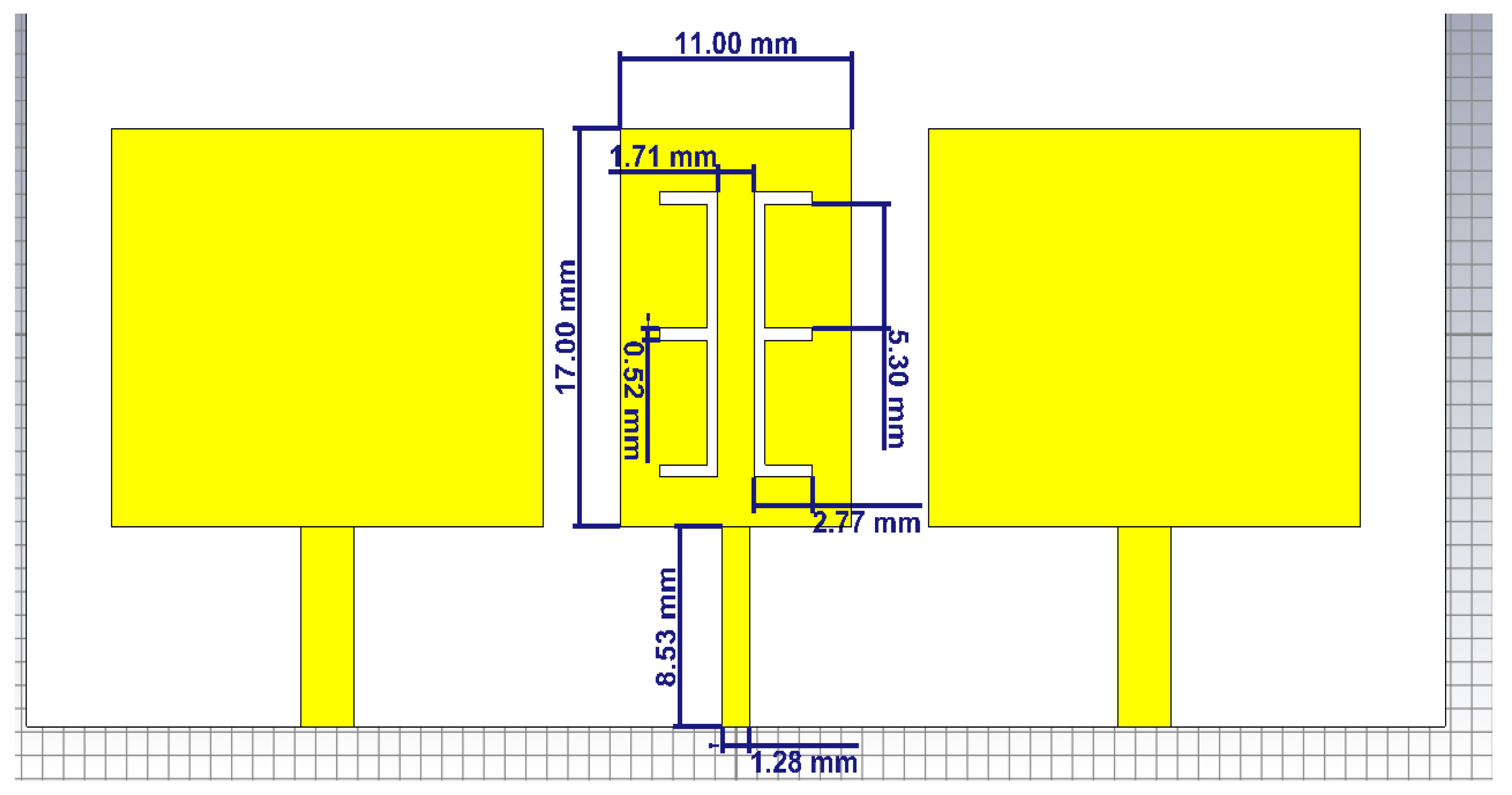

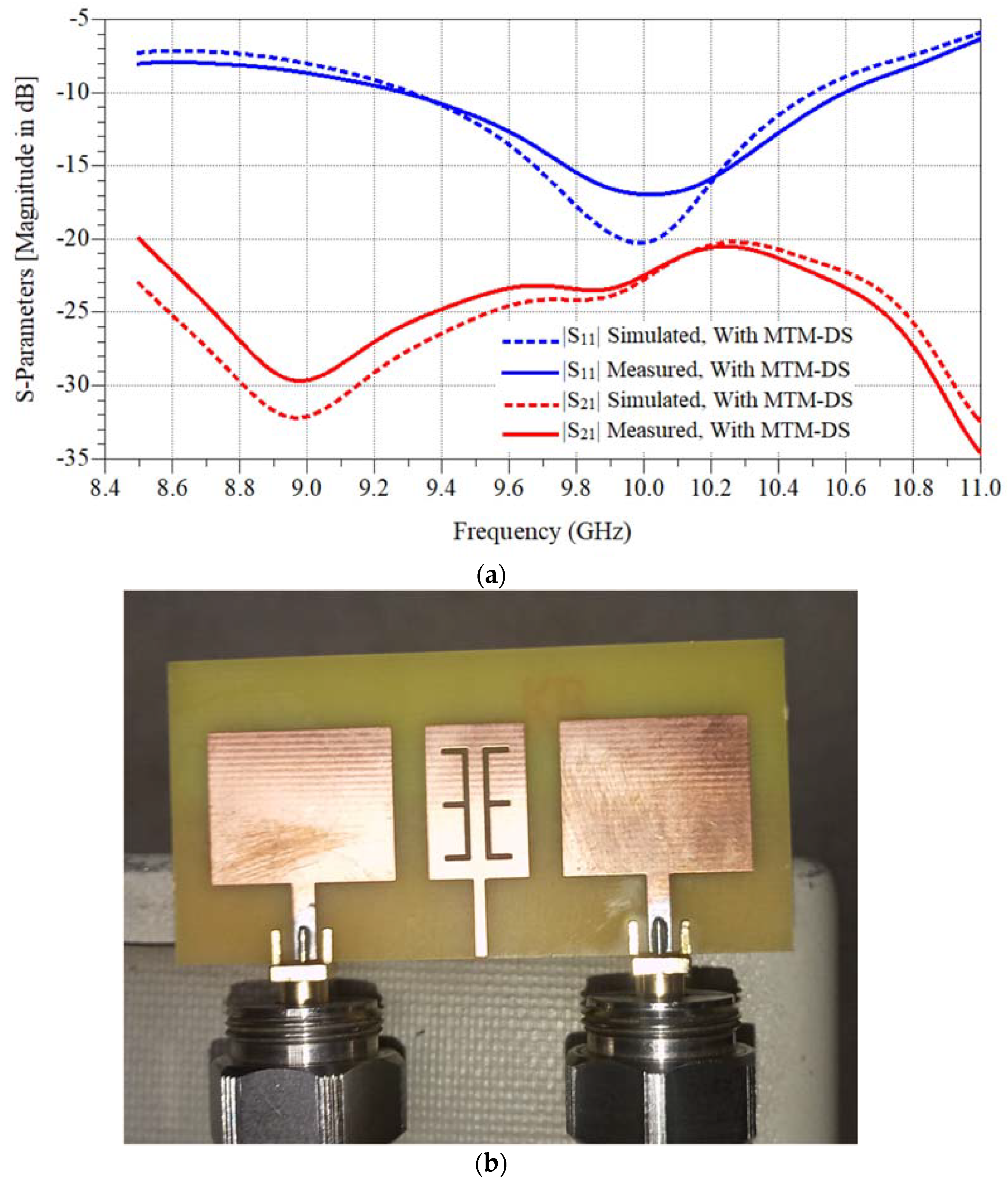
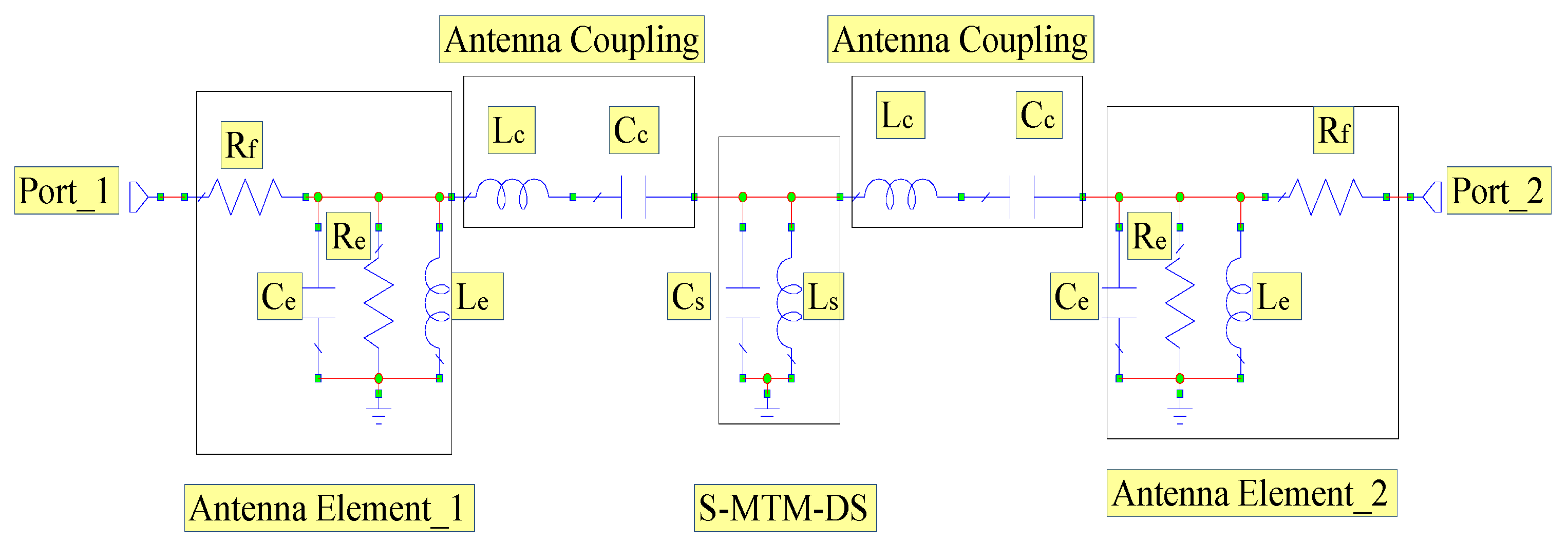
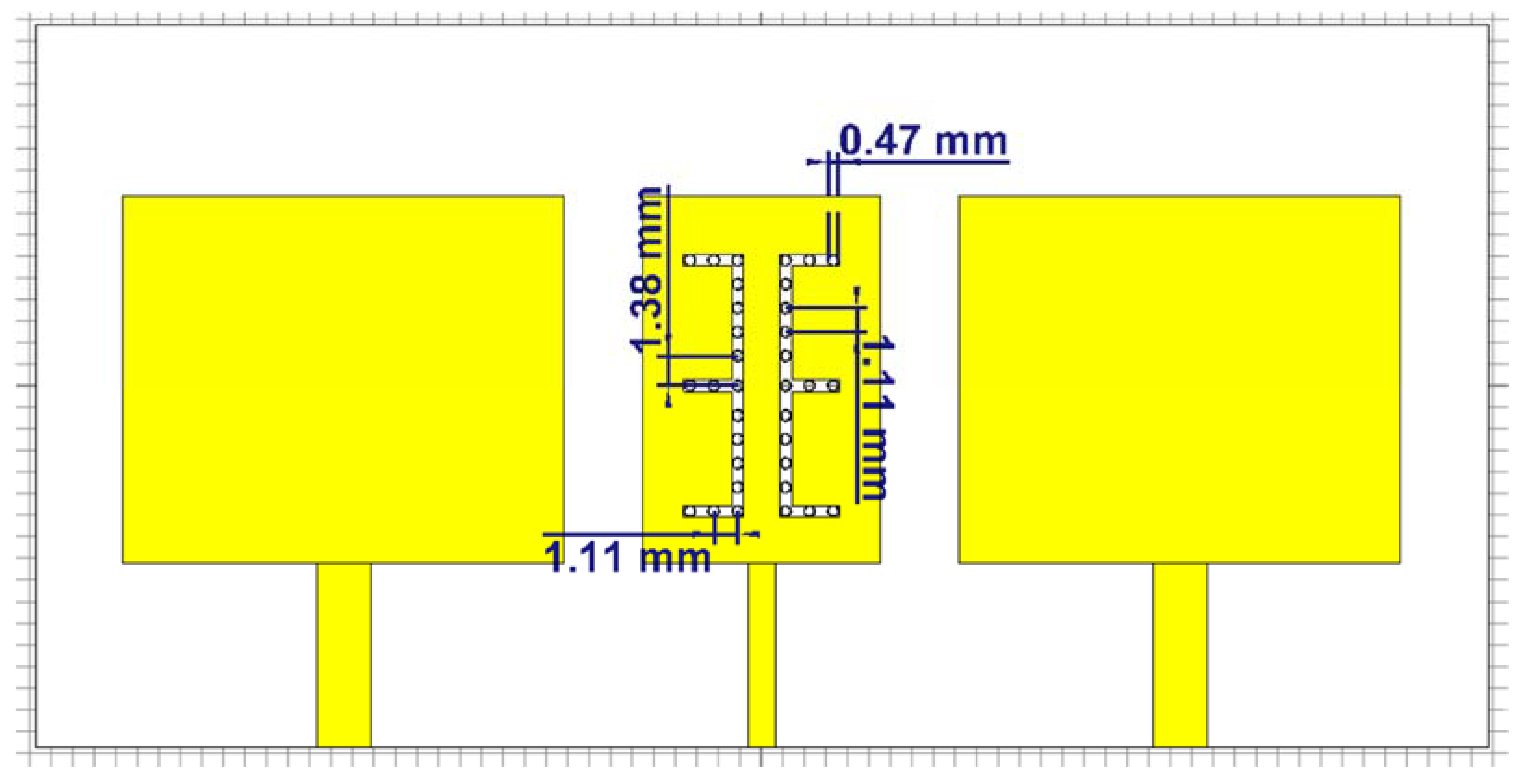
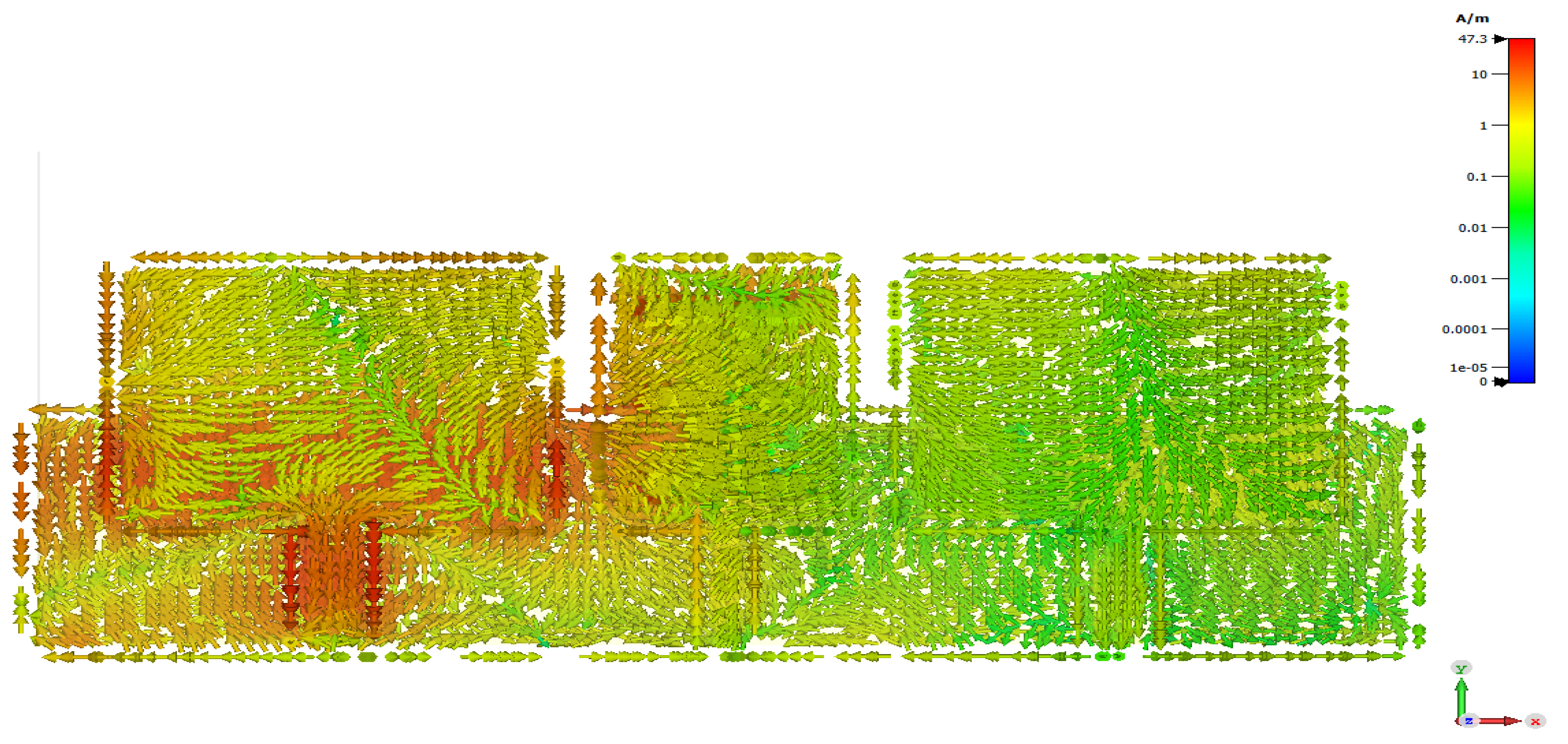
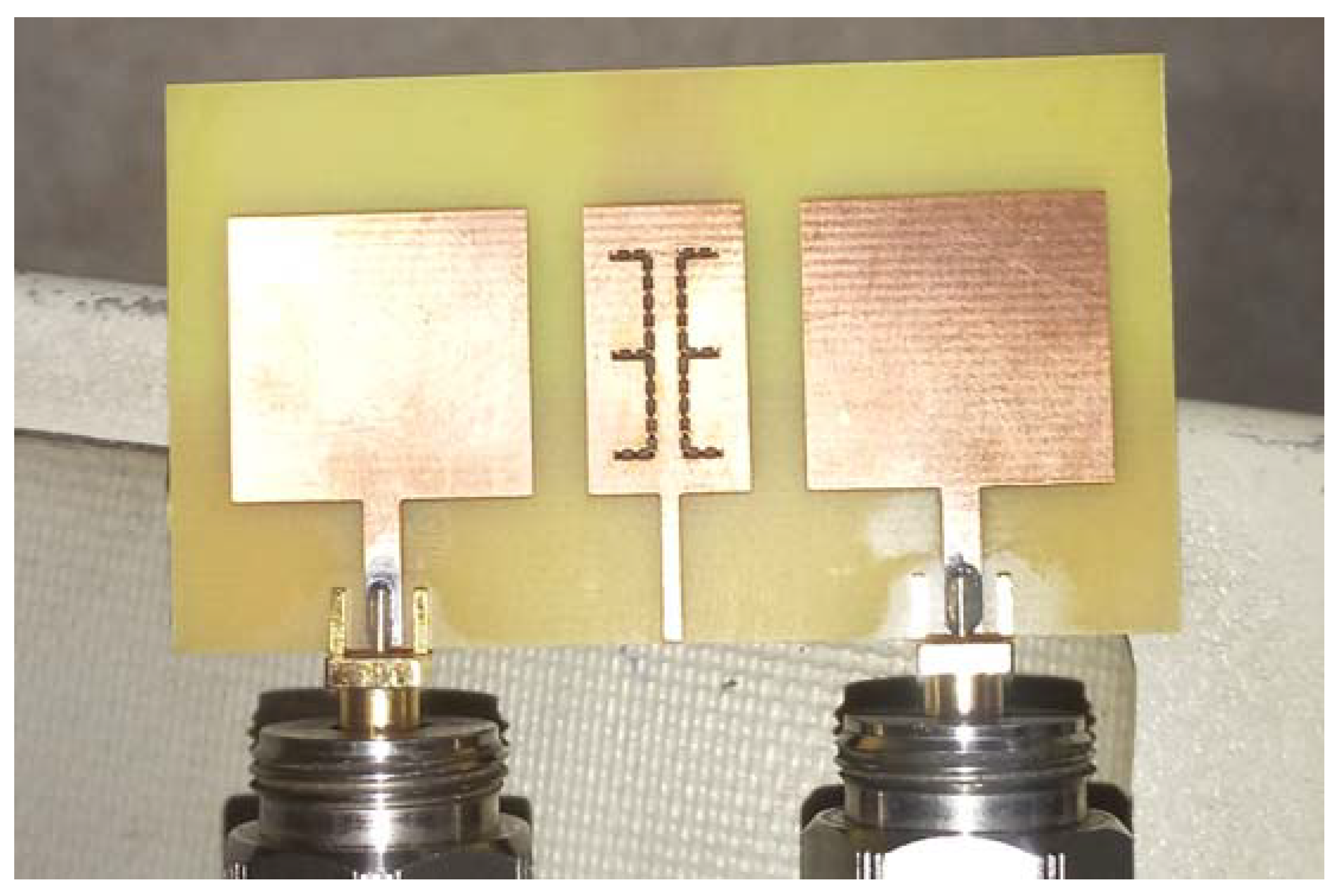

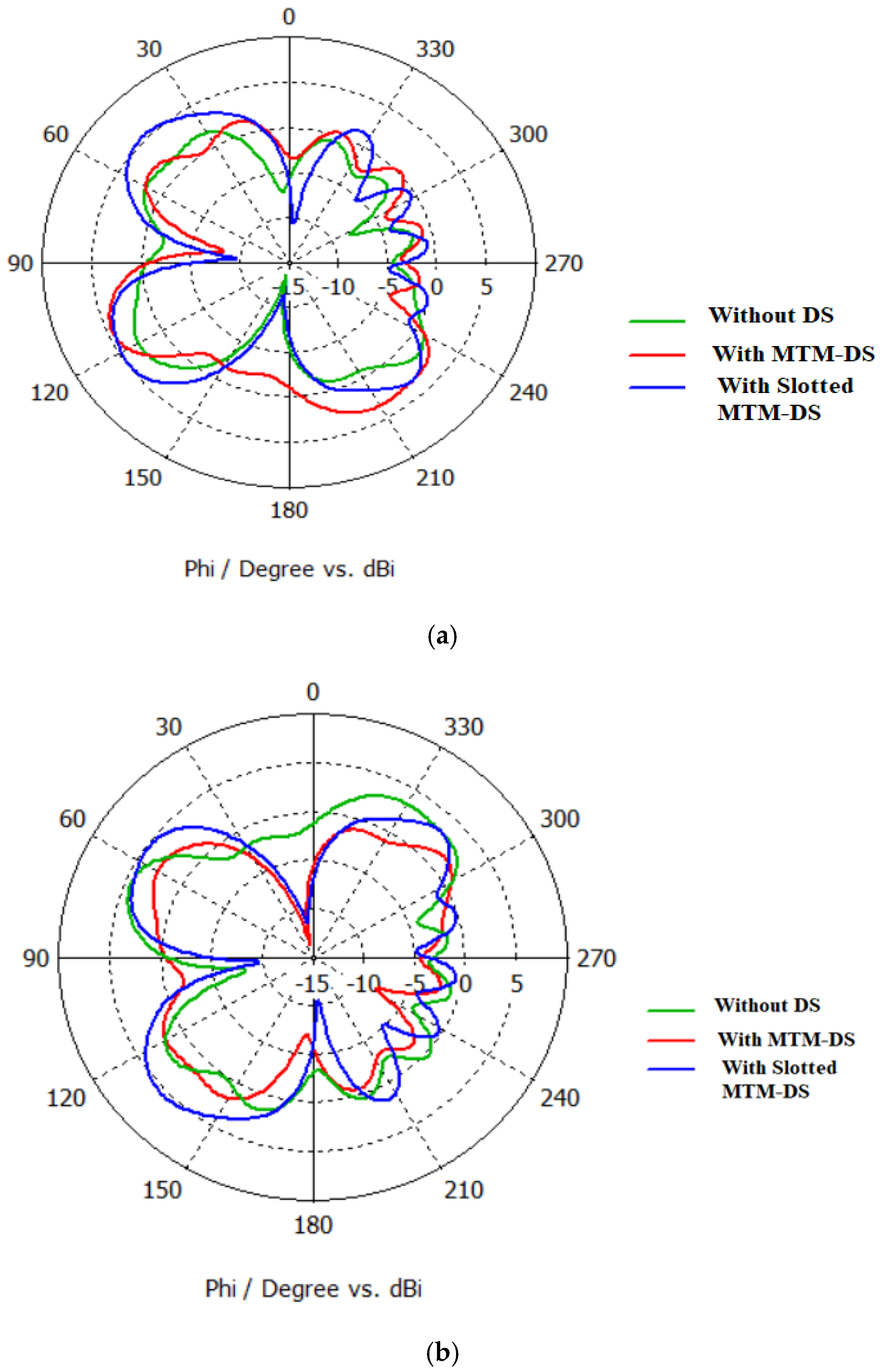
| Parameter | Values |
|---|---|
| Rf | 54 Ohm |
| Re | 1.9 Ohm |
| Ce | 0.65 pF |
| Le | 4.29 nH |
| Lc | 0.18 nH |
| Cc | 2.66 pF |
| Ls | 0.68 nH |
| Cs | 4.05 pF |
| Case | Operation BW (GHz) | BW (GHz) S11 < 10 dB | Fraction BW (%) | Mutual Coupling Suppression between Antenna Array(dB) | ||
|---|---|---|---|---|---|---|
| Min | Ave | Max | ||||
| Without DS | 9.22–10.5 | 1.28 | 12.98 | −14.5 | −18 | −23.7 |
| With MTM-DS | 9.3–10.5 | 1.2 | 12.12 | −20.2 | −23.8 | −27.5 |
| With slotted MTM-DS | 8.67–10.18 | 1.51 | 16.08 | −28.5 | −36 | −43.7 |
| Ref | Method | Max. Isolation Improvement | Patch Separation (λ0) | Operating Bandwidth Reduction (%) | Average Percentage | Design Complexity | Cost |
|---|---|---|---|---|---|---|---|
| [19] | Shorted annular elliptical patch | 8 (14%) | 0.75 (16%) | 81% | 37% | Moderate | Medium |
| [20] | Ring of magnetic current | 10 (18%) | 0.5 (25%) | 87% | 40% | Moderate | Medium |
| [16] | Complementary split-ring resonators | 37 (65%) | 0.125 (100%) | 100% | 88% | High | High |
| [21] | meta-surface wall isolator | 13.5 (24%) | 1.16 (11%) | 100% | 45% | Low | Low |
| [17] | Complementary split-ring resonator | 27 (47%) | 0.125 (100%) | 71% | 73% | Low | Low |
| [22] | U-shaped microstrip line | 17 (30%) | 0.75 (16%) | 88% | 45% | Moderate | Medium |
| [23] | Periodically grounded edge-coupled split-ring resonators | 18 (32%) | 0.5 (25%) | 100% | 52% | High | High |
| [18] | meta-material decoupling slab | 57 (100%) | 0.66 (19%) | 100% | 73% | Low | Low |
| Proposed Work | slotted meta-material decoupling slab | 43.7 (76%) | 0.57 (22%) | 100% | 66% | Moderate | Low |
Publisher’s Note: MDPI stays neutral with regard to jurisdictional claims in published maps and institutional affiliations. |
© 2021 by the authors. Licensee MDPI, Basel, Switzerland. This article is an open access article distributed under the terms and conditions of the Creative Commons Attribution (CC BY) license (https://creativecommons.org/licenses/by/4.0/).
Share and Cite
Moussa, K.H.; Amar, A.S.I.; Mabrouk, M.; Mohamed, H.G. Slotted E-Shaped Meta-Material Decoupling Slab for Densely Packed MIMO Antenna Arrays. Micromachines 2021, 12, 873. https://doi.org/10.3390/mi12080873
Moussa KH, Amar ASI, Mabrouk M, Mohamed HG. Slotted E-Shaped Meta-Material Decoupling Slab for Densely Packed MIMO Antenna Arrays. Micromachines. 2021; 12(8):873. https://doi.org/10.3390/mi12080873
Chicago/Turabian StyleMoussa, Karim H., Ahmed S. I. Amar, Mohamed Mabrouk, and Heba G. Mohamed. 2021. "Slotted E-Shaped Meta-Material Decoupling Slab for Densely Packed MIMO Antenna Arrays" Micromachines 12, no. 8: 873. https://doi.org/10.3390/mi12080873
APA StyleMoussa, K. H., Amar, A. S. I., Mabrouk, M., & Mohamed, H. G. (2021). Slotted E-Shaped Meta-Material Decoupling Slab for Densely Packed MIMO Antenna Arrays. Micromachines, 12(8), 873. https://doi.org/10.3390/mi12080873







